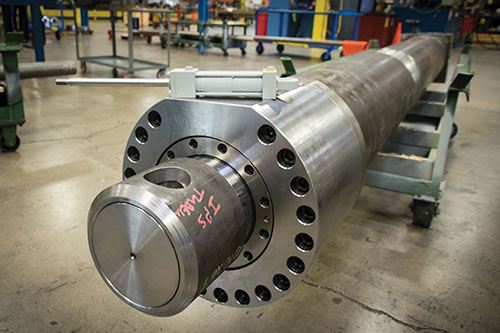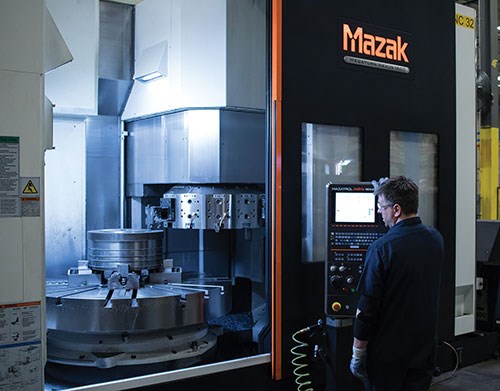Increasing Production with Fewer Machines
Hanna Cylinders needed to shorten production lead times and speed deliveries. Replacing several of its legacy machines with Mazak machine tools helped to increase jobs shipped per month and brought production in-house, even with fewer overall machines.
It may seem counterintuitive, but sometimes having fewer machines can help a shop increase its production capacity. Hanna Cylinders of Pleasant Prairie, Wisconsin, realized this after it brought in advanced machine tools from Mazak Corp. (Florence, Kentucky) that replaced several pieces of legacy equipment. By doing so, the company was able to ship 40 percent more jobs per month, enabling it to keep more than 98 percent of both its tie-rod and mobile-type cylinder production in-house, as well as its new “quarter-turn” types.
Hanna manufactures pneumatic and hydraulic cylinders that range in bore size from 1.5 to 60 inches in diameter with strokes as long as 400 inches. Approximately 75 percent of its production operations encompass low-volume custom orders, but the remainder is high-volume standard products for OEMs with orders that can average as many as 700 cylinders per day.
In 2011, General Manager Jim Warneke and Manufacturing Engineer Frank Laratta came on board to try to shorten production lead times and speed deliveries. The men say they implemented lean processes wherever they could, but they soon realized that the entire manufacturing flow on the shop floor needed to be revamped.
“From the start, our biggest manufacturing challenge was our equipment,” Mr. Laratta says. “We basically had one of everything and zero flexibility in terms of shifting parts to different machines in the event of downtime for repairs or maintenance.”
To remedy this, Hanna acquired nine new machine tools from Mazak, enabling the company to reduce its overall machine tool inventory from 50 machines to 30 CNC machines, 20 of which are Mazaks. The new machines not only helped streamline the equipment lineup, but also enabled the company to switch parts (along with their associated tooling and setups) from one machine to another when needed, with minimal effort, Mr. Laratta says.
Another benefit of the Mazak machines is that they enabled Hanna to bring almost all processes back in-house, especially the larger size cylinder components. The Megaturn Nexus (MTN) 1600M vertical turning center, for instance, features an 80-hp main spindle that delivers a maximum speed of 350 rpm and maximum torque of 7,405 foot-pounds to accommodate workpieces ranging to 64.96 inches in diameter and 35.43 inches tall, and weighing as much as 11,023 pounds. Its rotary tool milling capability and 12-tool, drum-style turret are designed to improve accuracy and productivity through reduced setups and workpiece handling.
Hanna also incorporated 12,000-rpm, 40-taper-spindle Vertical Center Nexus (VCN) 700E/40-II and VCN 510C-II (now identified as the Mazak VCN 530C-II model) vertical machining centers, and several models of Quick Turn Nexus (QTN) turning centers. The VCN 700E/40-II features a 30-tool magazine and 80-inch X-axis travel, and the VCN 510C-II features 41.3 inches of X-axis travel and a larger, 48-tool storage capacity.
Aside from investing in new machines, Hanna reorganized its shop floor so the workflow path is now shorter. Parts can flow through the shop based not only on size and features, but also on customer needs, specific delivery times and whether they are part of a stock job. Plus, instead of handling only one specific part size, the shop’s machining cells now process various sizes of a particular part or family of parts.
“While adding advanced machine tool technology was a huge factor in our production improvements, simply restructuring part flow into simple straight lines made just as big an impact as the machines,” Mr. Warneke says.
In addition to being lean, Hanna’s operations must be flexible and setups/change-overs as fast as possible in order for the shop to remain competitive. The flexibility of the Mazaks enable Hanna to set up for what it runs 90 percent of the time and work in the remaining 10 percent of unscheduled parts with less disruption to the shop.
To shorten setup times, Hanna uses simple setups and quick-change tooling/workholding wherever possible, in addition to standardized workstations and machining cells that are equipped with all the necessary hand tools and gages. For example, the shop made special vise jaws that enable it to hold square-shaped parts in the QTN’s three-jaw chuck. This eliminates the hassle of switching over to either a two- or four-jaw chuck.
On-machine tool-touch measuring, along with ample tool storage capacities, help further reduce setup times and speed job change-overs. According to Mr. Laratta, the shop’s machinists teach tool location on the Mazak machines by simply touching the tooltip to the machine’s Tool Eye automatic tooltip measuring system. Prior to such capability, the shop had to make a test cut, measure the part, run the tool back to home and make the necessary offset adjustment, he says. This lengthy process often resulted in at least one scrapped part.
While finished parts can end up different from one another, many of them start out the same. Part modularity, wherever possible, helps reduce cycle times as well as overall job turnaround. The shop will machine parts to certain semi-finished stages, stock them and finish-machine them to a customer’s specific needs. The shop determines what to stock semi-finished based on customer order history, and on the most popular sizes and types produced. What is stocked semi-finished can often change, however.
The Mazaks’ common-platform controls also reduce job change-over and turnaround times. The shop trains all its machinists to program the Mazaks so they can do their own setups and programming at the machines, as well as seamlessly move from operating one type of Mazak to the next. This increases throughput and eliminates time wasted waiting for programs that were developed offline then sent out to the shop floor. In some instances in which job lot sizes were only four or six components, waiting for the program could take longer than actually machining the parts.
The Mazak controls provide conversational or EIA programming, and they feature onboard graphics that display exactly where problems might occur. With such capability, the machinist can quickly fix problems without having to run back and forth between a programming office and the shop floor.
“On our older machines, we’d typically scrap two or three pieces trying to get that first good part,” Mr. Laratta says. “On the Mazaks, the first piece is a good one, and we can keep programs right in the machine controls.”
The controls and other features of the Mazak machines were a big part of the complete culture change at Hanna. According to Mr. Warneke, they have changed the way the shop manufactures. It can now instantaneously react to changing customer needs and provide high-quality cylinders delivered as quickly as possible.
Related Content
8 Ways to Increase Productivity on the Manufacturing Floor
When it comes to machine shop productivity, continuous improvement depends on efficient employees, equipment and processes.
Read MoreFinally, A Comprehensive Software Solution Designed for Small Job Shops
Zel X from Siemens is an integrated software application that consolidates collaboration, design, manufacturing, and operations into a comprehensive, easy-to-use solution. From RFQ to delivery, it’s a more efficient way to handle quotes, manage jobs, make parts, and collaborate with teams of all sizes.
Read MoreSame Headcount, Double the Sales: Successful Job Shop Automation
Doubling sales requires more than just robots. Pro Products’ staff works in tandem with robots, performing inspection and other value-added activities.
Read MoreWill the “Great Resignation” Become an Opportunity for Manufacturers? Get Ready for the Returning 3 Million
The Great Resignation will become a Great Reapplication when employees currently able to stay out of the workforce return to it looking for something better. Machining employers that are already evaluating candidates for fit, without demanding specific skills coming in, might be positioned well to draw upon this wave.
Read MoreRead Next
The Cut Scene: The Finer Details of Large-Format Machining
Small details and features can have an outsized impact on large parts, such as Barbco’s collapsible utility drill head.
Read More3 Mistakes That Cause CNC Programs to Fail
Despite enhancements to manufacturing technology, there are still issues today that can cause programs to fail. These failures can cause lost time, scrapped parts, damaged machines and even injured operators.
Read More.jpg;maxWidth=970;quality=90)












.jpg;maxWidth=300;quality=90)













.png;maxWidth=300;quality=90)







